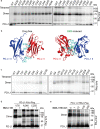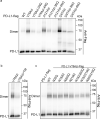Homodimerized cytoplasmic domain of PD-L1 regulates its complex glycosylation in living cells
- PMID: 36042378
- PMCID: PMC9427764
- DOI: 10.1038/s42003-022-03845-4
Homodimerized cytoplasmic domain of PD-L1 regulates its complex glycosylation in living cells
Abstract
Whether membrane-anchored PD-L1 homodimerizes in living cells is controversial. The biological significance of the homodimer waits to be expeditiously explored. However, characterization of the membrane-anchored full-length PD-L1 homodimer is challenging, and unconventional approaches are needed. By using genetically incorporated crosslinkers, we showed that full length PD-L1 forms homodimers and tetramers in living cells. Importantly, the homodimerized intracellular domains of PD-L1 play critical roles in its complex glycosylation. Further analysis identified three key arginine residues in the intracellular domain of PD-L1 as the regulating unit. In the PD-L1/PD-L1-3RE homodimer, mutations result in a decrease in the membrane abundance and an increase in the Golgi of wild-type PD-L1. Notably, PD-1 binding to abnormally glycosylated PD-L1 on cancer cells was attenuated, and subsequent T-cell induced toxicity increased. Collectively, our study demonstrated that PD-L1 indeed forms homodimers in cells, and the homodimers play important roles in PD-L1 complex glycosylation and T-cell mediated toxicity.
© 2022. The Author(s).
Conflict of interest statement
The authors declare no competing interests.
Figures







Similar articles
-
Genetically incorporated crosslinkers identify regulators of membrane protein PD-L1 in mammalian cells.Cell Chem Biol. 2023 Nov 16;30(11):1488-1497.e5. doi: 10.1016/j.chembiol.2023.07.004. Epub 2023 Aug 3. Cell Chem Biol. 2023. PMID: 37541256
-
Resveratrol targets PD-L1 glycosylation and dimerization to enhance antitumor T-cell immunity.Aging (Albany NY). 2020 Jan 4;12(1):8-34. doi: 10.18632/aging.102646. Epub 2020 Jan 4. Aging (Albany NY). 2020. PMID: 31901900 Free PMC article.
-
PD-L1 degradation is regulated by electrostatic membrane association of its cytoplasmic domain.Nat Commun. 2021 Aug 24;12(1):5106. doi: 10.1038/s41467-021-25416-7. Nat Commun. 2021. PMID: 34429434 Free PMC article.
-
The impact of PD-L1 N-linked glycosylation on cancer therapy and clinical diagnosis.J Biomed Sci. 2020 Jul 3;27(1):77. doi: 10.1186/s12929-020-00670-x. J Biomed Sci. 2020. PMID: 32620165 Free PMC article. Review.
-
Posttranslational Modifications of PD-L1 and Their Applications in Cancer Therapy.Cancer Res. 2018 Nov 15;78(22):6349-6353. doi: 10.1158/0008-5472.CAN-18-1892. Cancer Res. 2018. PMID: 30442814 Free PMC article. Review.
Cited by
-
B7 family protein glycosylation: Promising novel targets in tumor treatment.Front Immunol. 2022 Dec 6;13:1088560. doi: 10.3389/fimmu.2022.1088560. eCollection 2022. Front Immunol. 2022. PMID: 36561746 Free PMC article. Review.
-
Balancing the Nanoscale Organization in Multivalent Materials for Functional Inhibition of the Programmed Death-1 Immune Checkpoint.ACS Nano. 2024 Jan 16;18(2):1381-1395. doi: 10.1021/acsnano.3c06552. Epub 2023 Dec 21. ACS Nano. 2024. PMID: 38126310 Free PMC article.
-
Post-translational modifications of cancer immune checkpoints: mechanisms and therapeutic strategies.Mol Cancer. 2025 Jul 8;24(1):193. doi: 10.1186/s12943-025-02397-5. Mol Cancer. 2025. PMID: 40629335 Free PMC article. Review.
-
Biospecific Chemistry for Covalent Linking of Biomacromolecules.Chem Rev. 2024 Jul 10;124(13):8516-8549. doi: 10.1021/acs.chemrev.4c00066. Epub 2024 Jun 24. Chem Rev. 2024. PMID: 38913432 Free PMC article. Review.
-
Covalent bicyclization of protein complexes yields durable quaternary structures.Chem. 2024 Feb 8;10(2):615-627. doi: 10.1016/j.chempr.2023.10.003. Chem. 2024. PMID: 38344167 Free PMC article.
References
Publication types
MeSH terms
Substances
LinkOut - more resources
Full Text Sources
Research Materials

